Alfa Romeo 166 2006 Owner handbook (in English)
Manufacturer: ALFA ROMEO, Model Year: 2006, Model line: 166, Model: Alfa Romeo 166 2006Pages: 272, PDF Size: 4.17 MB
Page 41 of 272
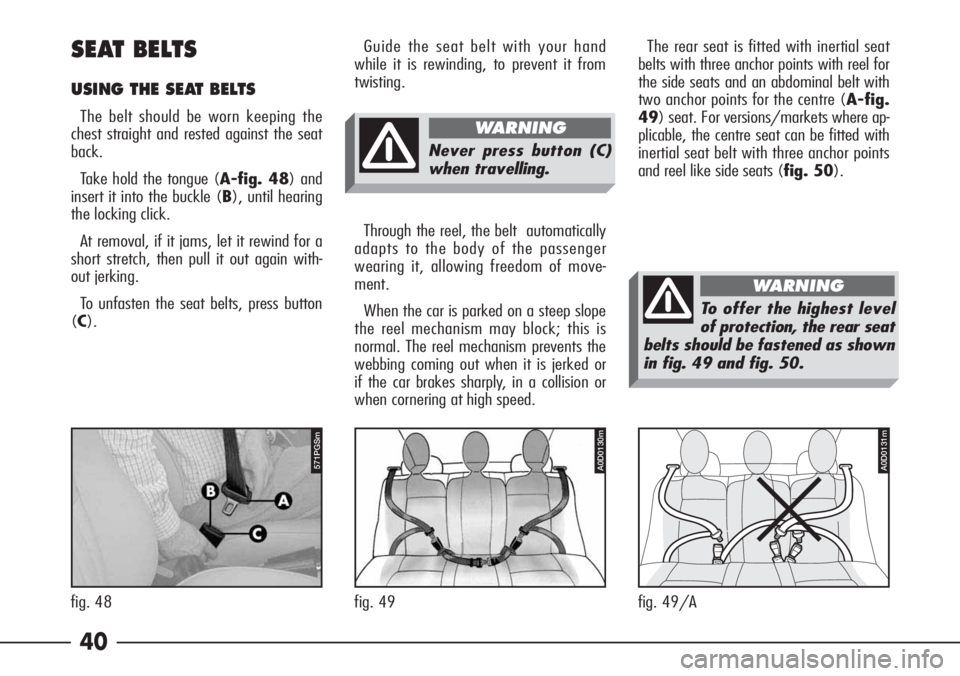
40 SEAT BELTS
USING THE SEAT BELTS
The belt should be worn keeping the
chest straight and rested against the seat
back.
Take hold the tongue (A-fig. 48) and
insert it into the buckle (B), until hearing
the locking click.
At removal, if it jams, let it rewind for a
short stretch, then pull it out again with-
out jerking.
To unfasten the seat belts, press button
(C).Guide the seat belt with your hand
while it is rewinding, to prevent it from
twisting.
Through the reel, the belt automatically
adapts to the body of the passenger
wearing it, allowing freedom of move-
ment.
When the car is parked on a steep slope
the reel mechanism may block; this is
normal. The reel mechanism prevents the
webbing coming out when it is jerked or
if the car brakes sharply, in a collision or
when cornering at high speed.The rear seat is fitted with inertial seat
belts with three anchor points with reel for
the side seats and an abdominal belt with
two anchor points for the centre (A-fig.
49) seat. For versions/markets where ap-
plicable, the centre seat can be fitted with
inertial seat belt with three anchor points
and reel like side seats (fig. 50).
Never press button (C)
when travelling.
WARNING
571PGSm
fig. 48fig. 49
A0D0130mA0D0131m
fig. 49/A
To offer the highest level
of protection, the rear seat
belts should be fastened as shown
in fig. 49 and fig. 50.
WARNING
Page 42 of 272
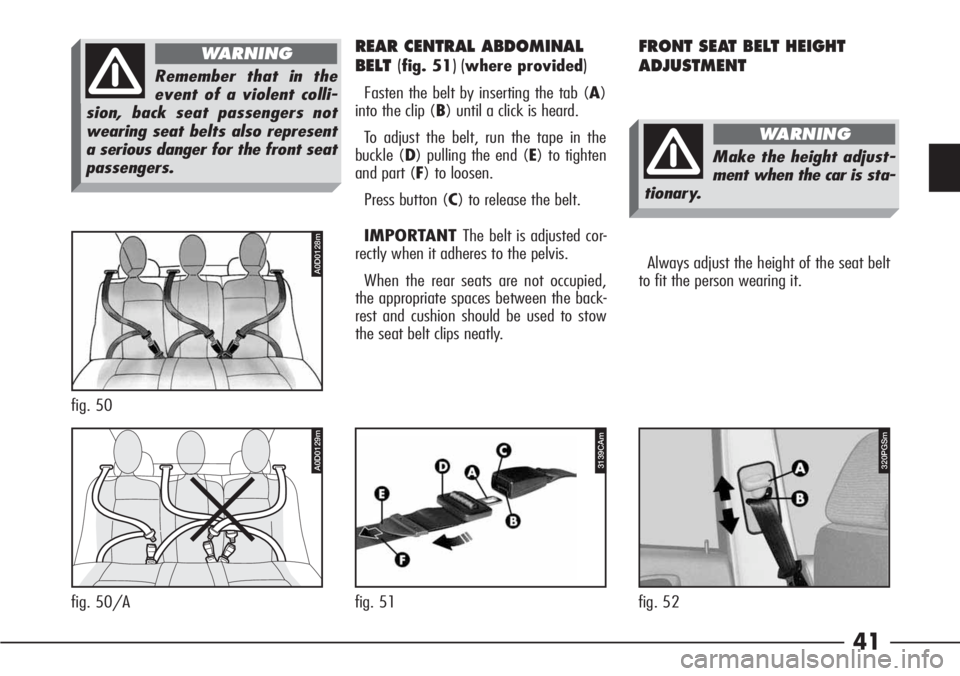
41
Remember that in the
event of a violent colli-
sion, back seat passengers not
wearing seat belts also represent
a serious danger for the front seat
passengers.
WARNING
fig. 50
A0D0128m
fig. 50/A
A0D0129m
REAR CENTRAL ABDOMINAL
BELT (
fig. 51) (where provided)
Fasten the belt by inserting the tab (A)
into the clip (B) until a click is heard.
To adjust the belt, run the tape in the
buckle (D) pulling the end (E) to tighten
and part (F) to loosen.
Press button (C) to release the belt.
IMPORTANT The belt is adjusted cor-
rectly when it adheres to the pelvis.
When the rear seats are not occupied,
the appropriate spaces between the back-
rest and cushion should be used to stow
the seat belt clips neatly.
FRONT SEAT BELT HEIGHT
ADJUSTMENT
Make the height adjust-
ment when the car is sta-
tionary.
WARNING
fig. 51fig. 52
320PGSm3139CAm
Always adjust the height of the seat belt
to fit the person wearing it.
Page 43 of 272
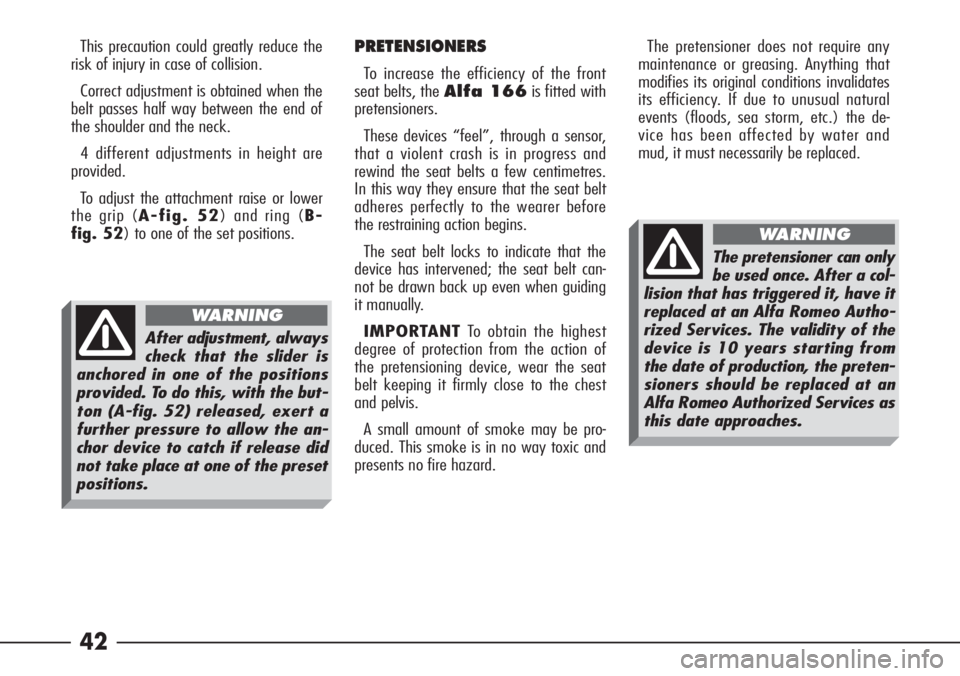
42
PRETENSIONERS
To increase the efficiency of the front
seat belts, the Alfa 166is fitted with
pretensioners.
These devices “feel”, through a sensor,
that a violent crash is in progress and
rewind the seat belts a few centimetres.
In this way they ensure that the seat belt
adheres perfectly to the wearer before
the restraining action begins.
The seat belt locks to indicate that the
device has intervened; the seat belt can-
not be drawn back up even when guiding
it manually.
IMPORTANTTo obtain the highest
degree of protection from the action of
the pretensioning device, wear the seat
belt keeping it firmly close to the chest
and pelvis.
A small amount of smoke may be pro-
duced. This smoke is in no way toxic and
presents no fire hazard.The pretensioner does not require any
maintenance or greasing. Anything that
modifies its original conditions invalidates
its efficiency. If due to unusual natural
events (floods, sea storm, etc.) the de-
vice has been affected by water and
mud, it must necessarily be replaced.
After adjustment, always
check that the slider is
anchored in one of the positions
provided. To do this, with the but-
ton (A-fig. 52) released, exert a
further pressure to allow the an-
chor device to catch if release did
not take place at one of the preset
positions.
WARNING
The pretensioner can only
be used once. After a col-
lision that has triggered it, have it
replaced at an Alfa Romeo Autho-
rized Services. The validity of the
device is 10 years starting from
the date of production, the preten-
sioners should be replaced at an
Alfa Romeo Authorized Services as
this date approaches.
WARNING
This precaution could greatly reduce the
risk of injury in case of collision.
Correct adjustment is obtained when the
belt passes half way between the end of
the shoulder and the neck.
4 different adjustments in height are
provided.
To adjust the attachment raise or lower
the grip (A-fig. 52) and ring (B-
fig. 52) to one of the set positions.
Page 44 of 272
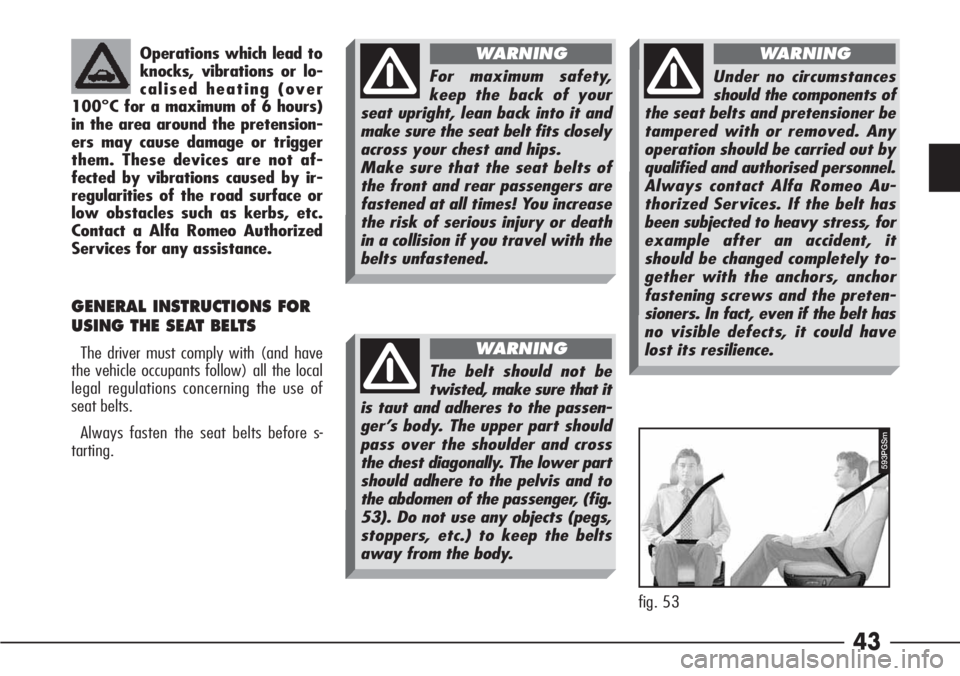
43
Operations which lead to
knocks, vibrations or lo-
calised heating (over
100°C for a maximum of 6 hours)
in the area around the pretension-
ers may cause damage or trigger
them. These devices are not af-
fected by vibrations caused by ir-
regularities of the road surface or
low obstacles such as kerbs, etc.
Contact a Alfa Romeo Authorized
Services for any assistance.
GENERAL INSTRUCTIONS FOR
USING THE SEAT BELTS
The driver must comply with (and have
the vehicle occupants follow) all the local
legal regulations concerning the use of
seat belts.
Always fasten the seat belts before s-
tarting.
For maximum safety,
keep the back of your
seat upright, lean back into it and
make sure the seat belt fits closely
across your chest and hips.
Make sure that the seat belts of
the front and rear passengers are
fastened at all times! You increase
the risk of serious injury or death
in a collision if you travel with the
belts unfastened.
WARNING
The belt should not be
twisted, make sure that it
is taut and adheres to the passen-
ger’s body. The upper part should
pass over the shoulder and cross
the chest diagonally. The lower part
should adhere to the pelvis and to
the abdomen of the passenger, (fig.
53). Do not use any objects (pegs,
stoppers, etc.) to keep the belts
away from the body.
WARNING
Under no circumstances
should the components of
the seat belts and pretensioner be
tampered with or removed. Any
operation should be carried out by
qualified and authorised personnel.
Always contact Alfa Romeo Au-
thorized Services. If the belt has
been subjected to heavy stress, for
example after an accident, it
should be changed completely to-
gether with the anchors, anchor
fastening screws and the preten-
sioners. In fact, even if the belt has
no visible defects, it could have
lost its resilience.
WARNING
593PGSm
fig. 53
Page 45 of 272
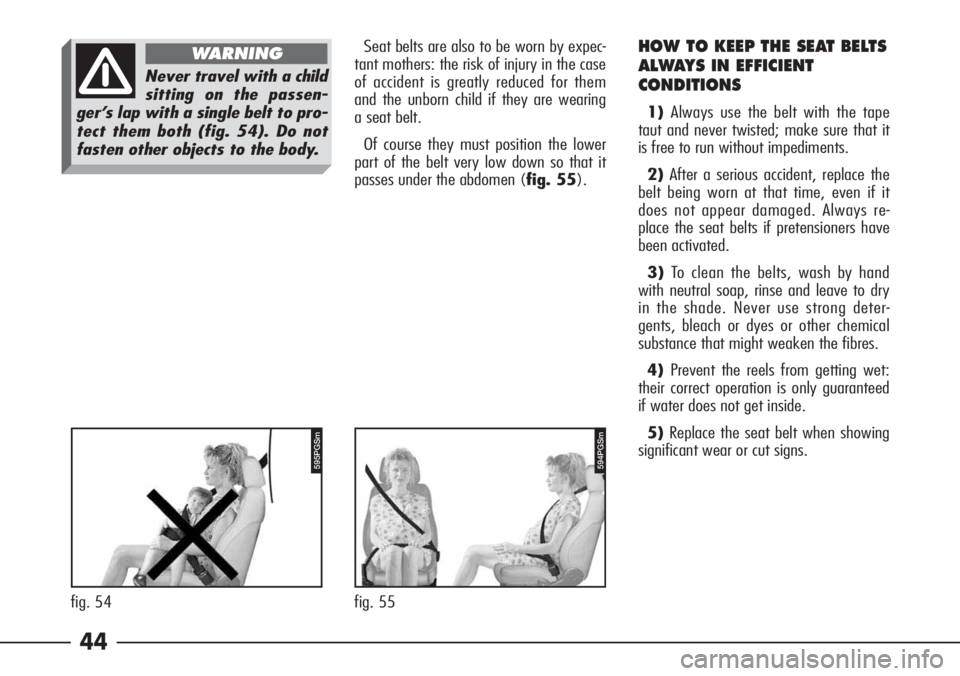
44
Seat belts are also to be worn by expec-
tant mothers: the risk of injury in the case
of accident is greatly reduced for them
and the unborn child if they are wearing
a seat belt.
Of course they must position the lower
part of the belt very low down so that it
passes under the abdomen (fig. 55).HOW TO KEEP THE SEAT BELTS
ALWAYS IN EFFICIENT
CONDITIONS
1)Always use the belt with the tape
taut and never twisted; make sure that it
is free to run without impediments.
2)After a serious accident, replace the
belt being worn at that time, even if it
does not appear damaged. Always re-
place the seat belts if pretensioners have
been activated.
3)To clean the belts, wash by hand
with neutral soap, rinse and leave to dry
in the shade. Never use strong deter-
gents, bleach or dyes or other chemical
substance that might weaken the fibres.
4)Prevent the reels from getting wet:
their correct operation is only guaranteed
if water does not get inside.
5)Replace the seat belt when showing
significant wear or cut signs.
Never travel with a child
sitting on the passen-
ger’s lap with a single belt to pro-
tect them both (fig. 54). Do not
fasten other objects to the body.
WARNING
595PGSm
fig. 54
594PGSm
fig. 55
Page 46 of 272
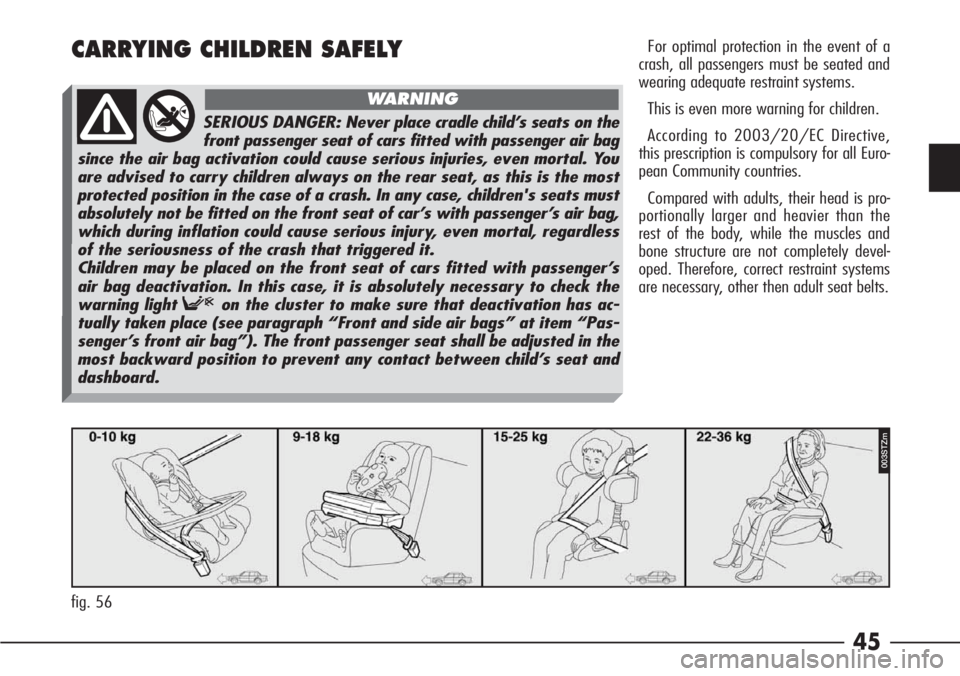
45
CARRYING CHILDREN SAFELYFor optimal protection in the event of a
crash, all passengers must be seated and
wearing adequate restraint systems.
This is even more warning for children.
According to 2003/20/EC Directive,
this prescription is compulsory for all Euro-
pean Community countries.
Compared with adults, their head is pro-
portionally larger and heavier than the
rest of the body, while the muscles and
bone structure are not completely devel-
oped. Therefore, correct restraint systems
are necessary, other then adult seat belts.
fig. 56
003STZm
SERIOUS DANGER: Never place cradle child’s seats on the
front passenger seat of cars fitted with passenger air bag
since the air bag activation could cause serious injuries, even mortal. You
are advised to carry children always on the rear seat, as this is the most
protected position in the case of a crash. In any case, children's seats must
absolutely not be fitted on the front seat of car’s with passenger’s air bag,
which during inflation could cause serious injury, even mortal, regardless
of the seriousness of the crash that triggered it.
Children may be placed on the front seat of cars fitted with passenger’s
air bag deactivation. In this case, it is absolutely necessary to check the
warning light
Fon the cluster to make sure that deactivation has ac-
tually taken place (see paragraph “Front and side air bags” at item “Pas-
senger’s front air bag”). The front passenger seat shall be adjusted in the
most backward position to prevent any contact between child’s seat and
dashboard.
AIRBAGWARNING
Page 47 of 272
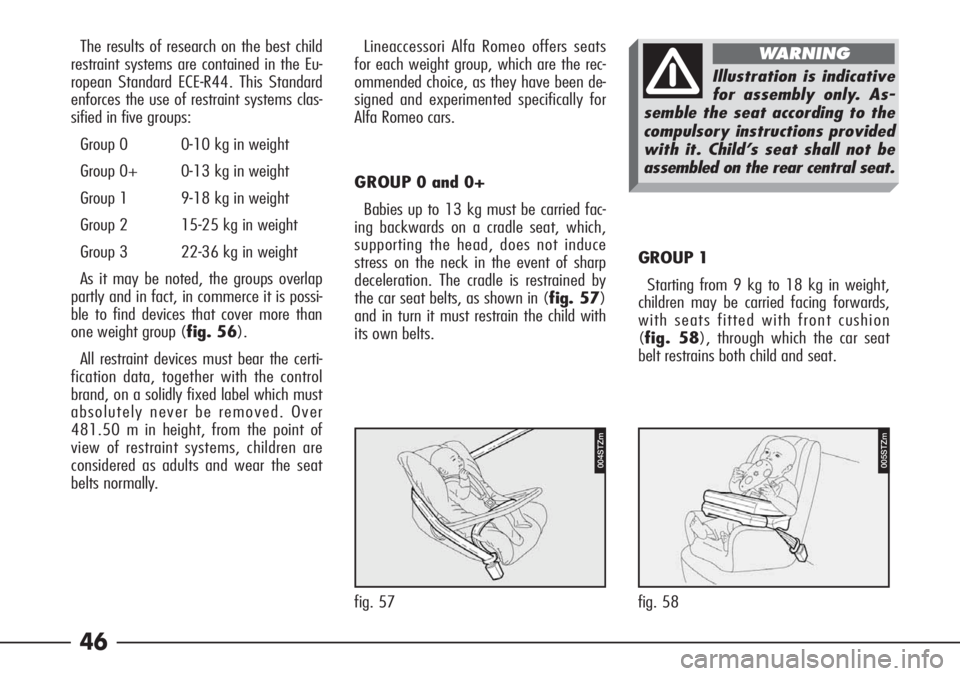
46
The results of research on the best child
restraint systems are contained in the Eu-
ropean Standard ECE-R44. This Standard
enforces the use of restraint systems clas-
sified in five groups:
Group 0 0-10 kg in weight
Group 0+ 0-13 kg in weight
Group 1 9-18 kg in weight
Group 2 15-25 kg in weight
Group 3 22-36 kg in weight
As it may be noted, the groups overlap
partly and in fact, in commerce it is possi-
ble to find devices that cover more than
one weight group (fig. 56).
All restraint devices must bear the certi-
fication data, together with the control
brand, on a solidly fixed label which must
absolutely never be removed. Over
481.50 m in height, from the point of
view of restraint systems, children are
considered as adults and wear the seat
belts normally.Lineaccessori Alfa Romeo offers seats
for each weight group, which are the rec-
ommended choice, as they have been de-
signed and experimented specifically for
Alfa Romeo cars.
GROUP 0 and 0+
Babies up to 13 kg must be carried fac-
ing backwards on a cradle seat, which,
supporting the head, does not induce
stress on the neck in the event of sharp
deceleration. The cradle is restrained by
the car seat belts, as shown in (fig. 57)
and in turn it must restrain the child with
its own belts.GROUP 1
Starting from 9 kg to 18 kg in weight,
children may be carried facing forwards,
with seats fitted with front cushion
(fig. 58), through which the car seat
belt restrains both child and seat.
004STZm
fig. 57 fig. 58
005STZm
Illustration is indicative
for assembly only. As-
semble the seat according to the
compulsory instructions provided
with it. Child’s seat shall not be
assembled on the rear central seat.
WARNING
Page 48 of 272
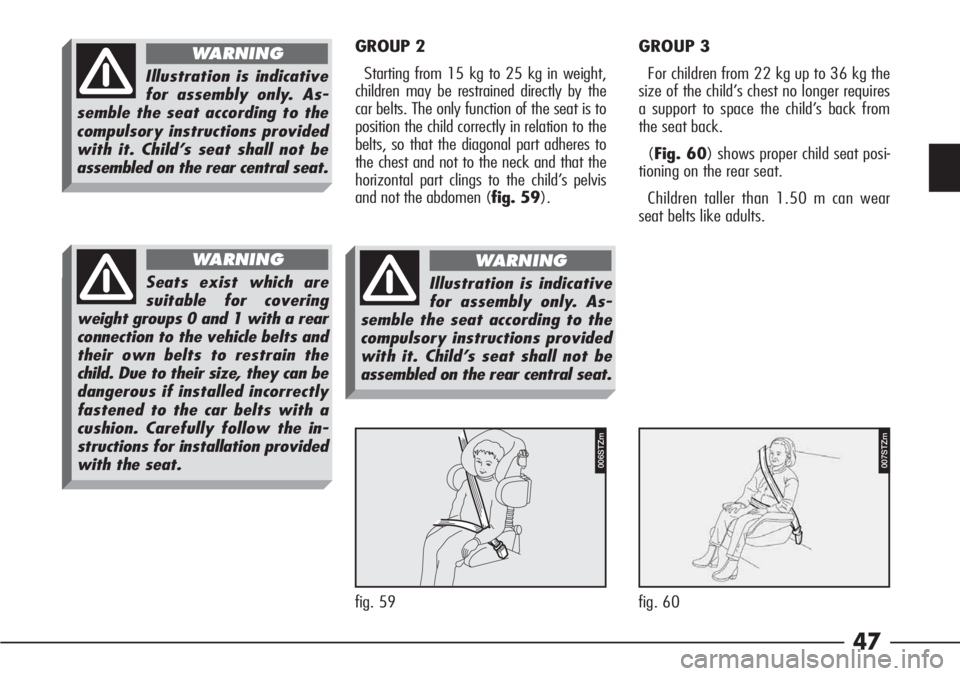
47
GROUP 2
Starting from 15 kg to 25 kg in weight,
children may be restrained directly by the
car belts. The only function of the seat is to
position the child correctly in relation to the
belts, so that the diagonal part adheres to
the chest and not to the neck and that the
horizontal part clings to the child’s pelvis
and not the abdomen (fig. 59).GROUP 3
For children from 22 kg up to 36 kg the
size of the child’s chest no longer requires
a support to space the child’s back from
the seat back.
(Fig. 60) shows proper child seat posi-
tioning on the rear seat.
Children taller than 1.50 m can wear
seat belts like adults.
006STZm007STZm
fig. 59 fig. 60
Seats exist which are
suitable for covering
weight groups 0 and 1 with a rear
connection to the vehicle belts and
their own belts to restrain the
child. Due to their size, they can be
dangerous if installed incorrectly
fastened to the car belts with a
cushion. Carefully follow the in-
structions for installation provided
with the seat.
WARNING
Illustration is indicative
for assembly only. As-
semble the seat according to the
compulsory instructions provided
with it. Child’s seat shall not be
assembled on the rear central seat.
WARNING
Illustration is indicative
for assembly only. As-
semble the seat according to the
compulsory instructions provided
with it. Child’s seat shall not be
assembled on the rear central seat.
WARNING
Page 49 of 272
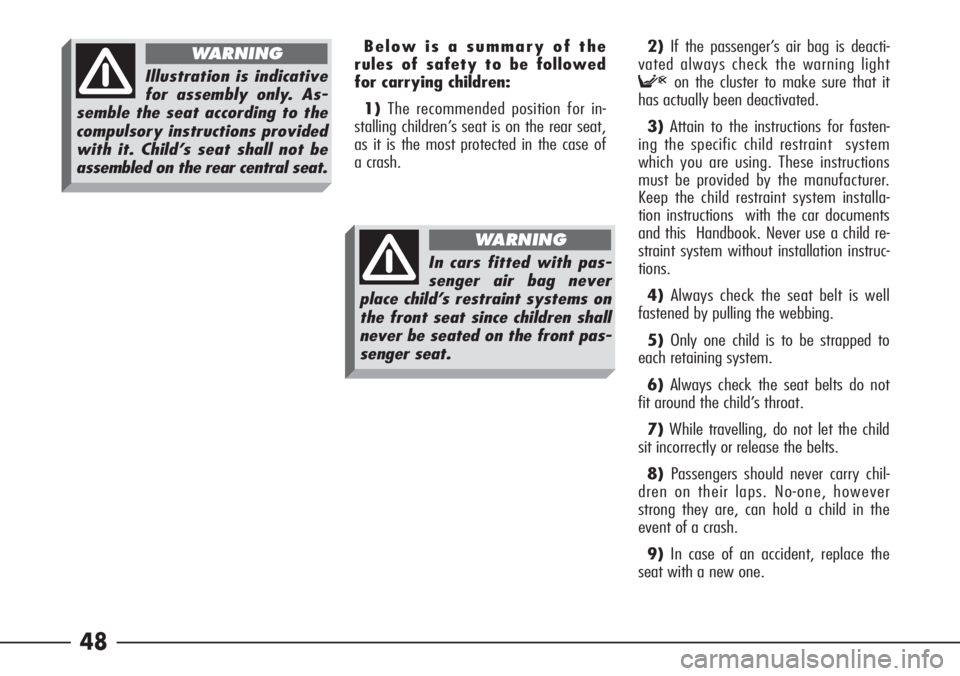
48
Below is a summary of the
rules of safety to be followed
for carrying children:
1)The recommended position for in-
stalling children’s seat is on the rear seat,
as it is the most protected in the case of
a crash.2)If the passenger’s air bag is deacti-
vated always check the warning light
Fon the cluster to make sure that it
has actually been deactivated.
3)Attain to the instructions for fasten-
ing the specific child restraint system
which you are using. These instructions
must be provided by the manufacturer.
Keep the child restraint system installa-
tion instructions with the car documents
and this Handbook. Never use a child re-
straint system without installation instruc-
tions.
4)Always check the seat belt is well
fastened by pulling the webbing.
5)Only one child is to be strapped to
each retaining system.
6)Always check the seat belts do not
fit around the child’s throat.
7)While travelling, do not let the child
sit incorrectly or release the belts.
8)Passengers should never carry chil-
dren on their laps. No-one, however
strong they are, can hold a child in the
event of a crash.
9)In case of an accident, replace the
seat with a new one.
In cars fitted with pas-
senger air bag never
place child’s restraint systems on
the front seat since children shall
never be seated on the front pas-
senger seat.
WARNING
Illustration is indicative
for assembly only. As-
semble the seat according to the
compulsory instructions provided
with it. Child’s seat shall not be
assembled on the rear central seat.
WARNING
Page 50 of 272
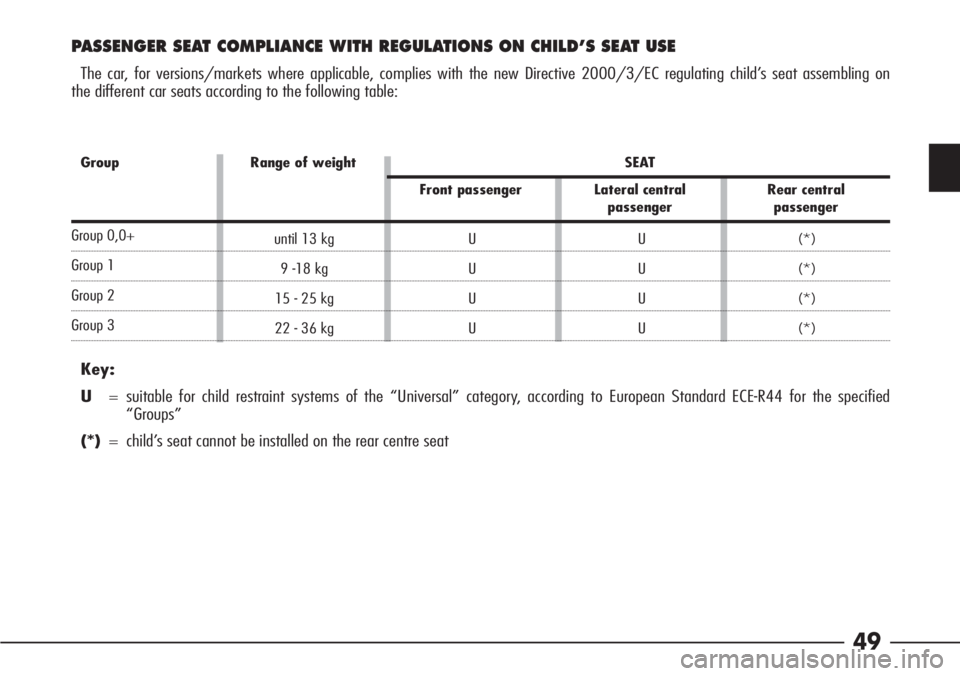
49
PASSENGER SEAT COMPLIANCE WITH REGULATIONS ON CHILD’S SEAT USE
The car, for versions/markets where applicable, complies with the new Directive 2000/3/EC regulating child’s seat assembling on
the different car seats according to the following table:
Key:
U= suitable for child restraint systems of the “Universal” category, according to European Standard ECE-R44 for the specified
“Groups”
(*)= child’s seat cannot be installed on the rear centre seat
Group Range of weight SEAT
Front passenger Lateral central Rear central
passenger passenger
Group 0,0+
Group 1
Group 2
Group 3 until 13 kg
9 -18 kg
15 - 25 kg
22 - 36 kgU
U
U
UU
U
U
U(*)
(*)
(*)
(*)